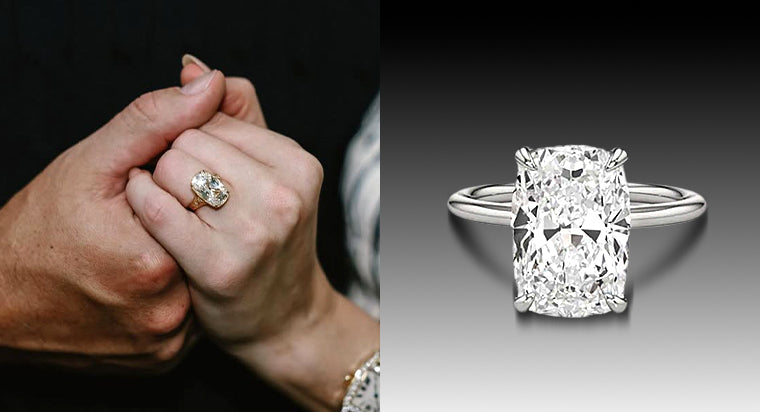Exploring the Brilliance: A Guide to Lab Grown Diamond Three Stone Engagement Rings

Lab grown diamonds have come a long way since they were invented in 1954. Technological advances have continued to improve the process of creating diamonds in a lab that mimics natural diamond-growing conditions. Basically, the lab recreates the high temperatures and pressure that turn carbon into gorgeous, glittering diamonds. Both lab and natural diamonds look the same physically, chemically, and optically. The difference is where they're made - either in a lab or the Earth's crust.
TABLE OF CONTENTS
Advantages of Lab Grown Diamonds
Lab grown diamonds come with some added benefits as well. They're more affordable than natural diamonds because much of the supply chain gets nixed. You know exactly where the diamonds are made, which makes it an ethical option if you're concerned about the unethically sourced diamonds. Getting a lab made diamond also means you're not disrupting the Earth or ecosystems by mining for diamonds. Lab diamonds are environmentally friendly and sustainable.
Three Stone Engagement Rings
Three-stone rings make stunning engagement rings. Three diamonds lined up on a ring look stunning on the finger. They're also symbolic rings because each diamond represents your relationship's past, present, and future. The past is your early adventures as a couple. Your present is the love you've nurtured and grown over time, and your future is getting engaged and building a life together.
Design Varieties
When you think of a three-stone engagement ring, you might think of three round diamonds. However, you'll see many different three-stone ring designs with lab grown diamonds. You'll see engagement rings with the same cut for the three stones, some that mix and match diamond cuts, and others that have three diamonds but also have diamonds along the band.
This petite three stone lab diamond ring has an oval center stone with two round diamonds on either side. You can also mix princess cuts with round diamonds, like this three stone princess studded ring that features an oval diamond and two princess cut diamonds on either side as well as a princess cut diamonds along the band. Here's another variation of a three-stone ring that features trillion diamonds as the side stones.
At With Clarity, you can customize the ring to make it your own by choosing the metal you prefer (platinum, 14K, or 18K yellow, rose, or white gold) for all design variations. You can also adjust the center stones to suit your individual preferences. Easily create the ring of your dreams by choosing your setting, center stone, and metal.
Quality and Certification
When choosing lab grown diamonds, make sure you choose diamonds from a reputable retailer that offers quality diamonds. It also helps if the lab diamonds are certified, which means a third party evaluates the stones to ensure you get exactly what you're paying for. Well-known organizations certify lab diamonds, including the Gemological Institute of America (GIA) and the International Gemological Institute (IGI). You'll receive a detailed report about your diamond that specifies the grade of the cut, color, clarity, and carat size of the diamond you chose.
Durability and Longevity
Diamonds are a ten on the Mohs hardness scale, which makes them the hardest substance in the world. This makes diamonds extraordinarily durable and ensures they'll last a lifetime. A common myth about lab grown diamonds is that they're not "real" diamonds, but that's completely false. Natural and lab diamonds look exactly the same physically, chemically, and optically. Only an expert can tell the difference between the two using a microscope. To the naked eye, they look the same. This means that both lab and natural diamonds are equally durable.
Caring for Lab Grown Diamonds
You want to ensure your lab grown diamonds last a lifetime, so taking care of them is essential. Your lab diamonds are extremely hard and can scratch other jewelry, so you'll want to store your engagement ring separately from other pieces. It's also important to clean your diamonds periodically at home to remove stuck-on dirt and grime. You can do this by soaking your ring in a warm bowl of water and gentle soap. Then, use a soft-bristled brush to scrub away stuck dirt. Removing the dirt helps your diamonds sparkle and look as good as new. You'll also want to inspect your ring professionally to ensure your diamonds are safe and secure in the settings and your prongs haven't worn down. Losing any of your diamonds would be devastating.
Trends and Popularity
Lab grown diamonds' popularity has skyrocketed in recent years, and the demand will only increase. More customers want diamonds that are sustainable and ethically sourced. Lab made diamonds provide peace of mind and also save some money without sacrificing quality or beauty. It's a win-win situation!
Final Thoughts
Three-stone lab grown diamond rings look gorgeous because of the trio of sparkling diamonds. They not only look stunning, but they carry meaning, representing the past, present, and future you have with your love. You'll see so many different three-stone ring variations so that you can get the ring of your dreams.
Customize it by picking the setting you adore, choosing the metal, and selecting a fantastic center lab diamond. Lab diamonds are affordable and come with the added benefits of being sustainable and ethical. Lab made diamonds is a popular choice and is here to stay.









